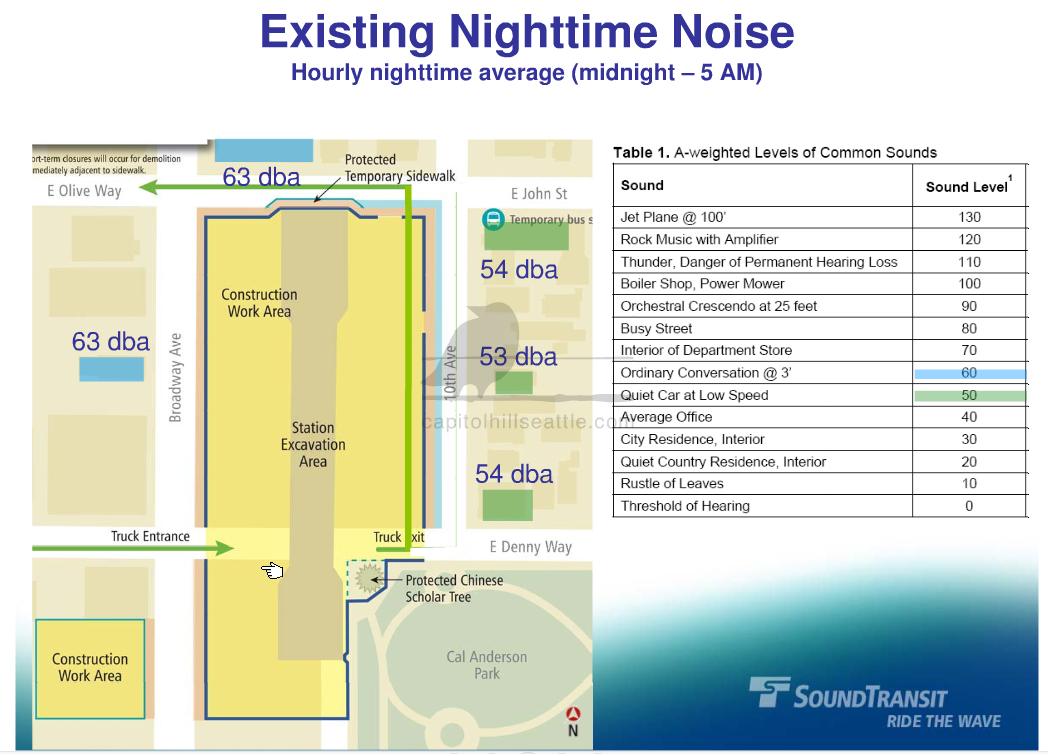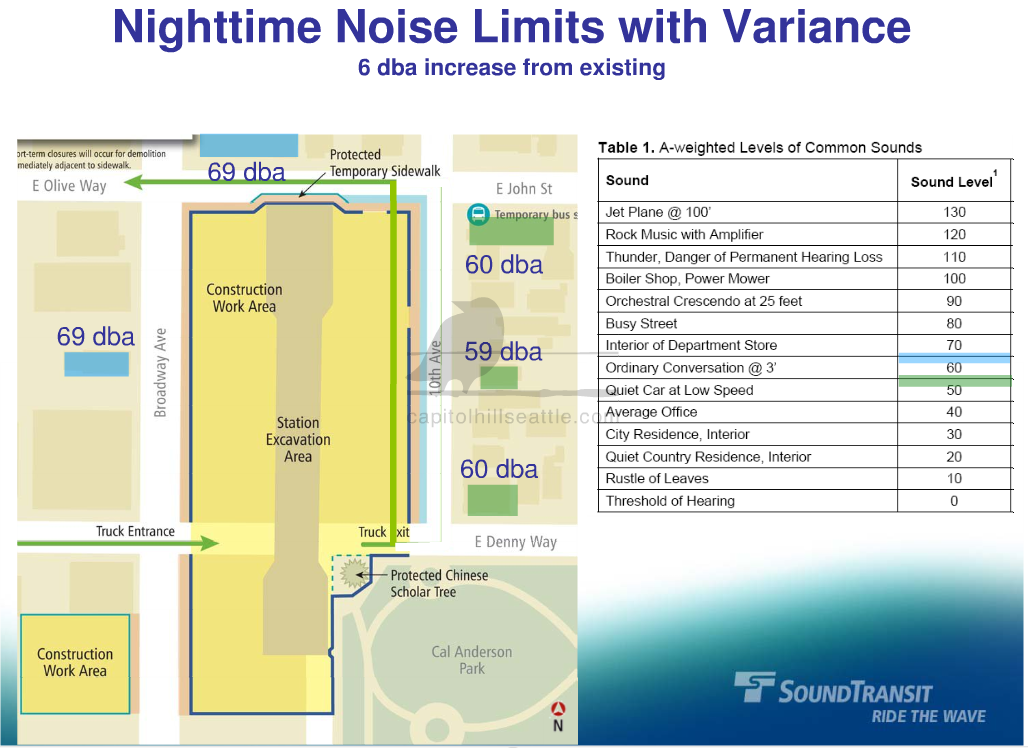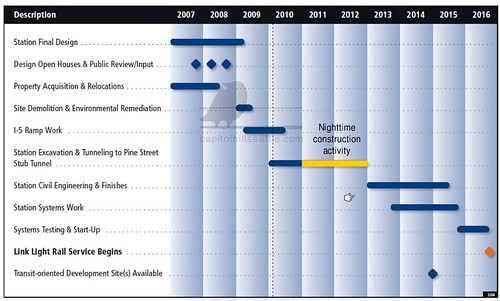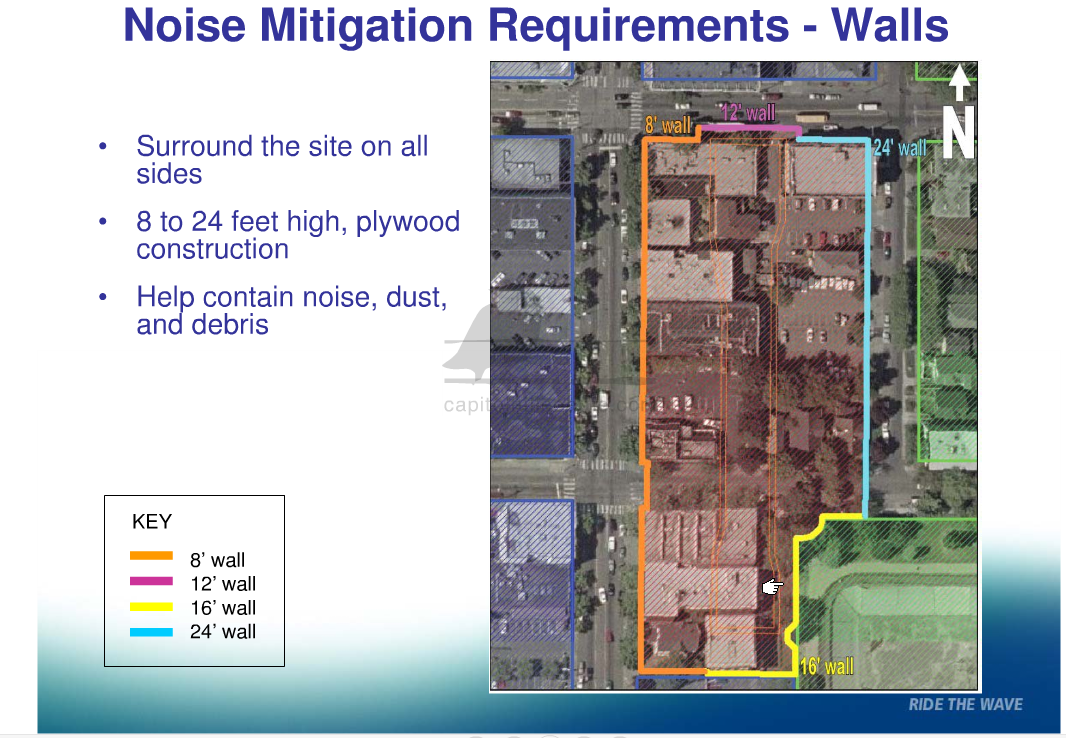24-hour-a-day work for the Capitol Hill light rail station construction and tunneling is a go. The City of Seattle has approved Sound Transit’s application for permission to exceed legal noise thresholds during nighttime construction. The approval will allow the agency’s contractors to run machinery 24 hours a day at the Broadway construction site between John and Denny so that the tunneling process does not need to be halted at night. From the Department of Planning and Development’s document approving the variance:
The only way to comply with sound level limits is to prohibit tunneling during nighttime hours. To do so would cause unsafe working conditions, would increase the risk of voids in the soil and subsidence of the surface above the tunnel, and would produce a hardship to the public because it would take longer and add more cost to complete the project.
Appeals of the decision must be submitted to DPD by May 3rd April 29 (DPD originally posted an incorrect date for this deadline) At a public hearing on the variance, only one community member spoke during the public comment portion of the meeting.
The noise variance specifically covers the hours of 10 PM to 7 AM on weekdays and 10 PM to 9 AM on weekends and holidays. At all other hours, the city’s regular daytime noise laws apply. Sound Transit has says that its contractors won’t enter the phase of construction the variance is required for until 2011.
The ‘variance’ in the process refers to the amount by which the sound levels can vary from the nighttime measured average for the area. As part of the application process, Sound Transit measured noise levels at areas near the station. Here are the levels Sound Transit measured from a meeting the agency hosted on the noise variance process:

The approval of Sound Transit’s application marks the first time DPD has processed a Major Public Project Construction Variance request. The new framework for major projects was approved by the City Council last March. The rules simplified the noise variance process for major public projects but also created safeguards including
Here is the full presentation on the noise variance that Sound Transit presented at a community meeting in February:
As part of the approval, DPD also considered the noise mitigation efforts Sound Transit has agreed to engage in including the large plywood walls being installed around the construction site and the banning the use of ‘tonal’ back-up alarms (beeep beeep beeep) on vehicles operating at night.







I live in the building across John on the north side of the construction site and I’m curious as to why we don’t get the 24′ sound wall. I can understand using shorter sound walls on the sides of the site facing, say, Cal Anderson, but it seems odd to place the shortest section of wall directly across from a big apartment building.
It’s something we can check on but I assume it has to do with the gate located on the north end. If you read the approval, you’ll note that the city and ST have acknowledged that noise on the north end will be higher because the gate will be open for truck traffic.
Wouldn’t the majority of the noise being output at that stage of the project occur underground? I know from the brightwater project that the vast majority of onsite construction noise comes from backup alarms, and the slurry mixer, which is pretty quiet. I can’t imagine it being steady construction noise as one might think.
The sooner the better. 24 hours of construction would be great considering they were originally going complete this thing in like 2016!!! That timeline is completely unacceptable. Many of us will either be dead or retired to the suburbs by then.
The 24-work is required to *hit* the 2016 start of service target. This won’t change the timeline.
Sound barriers such as wooden walls around construction sites do very little to block sound at any distance from the site, especially if they are only 24 foot high. The sound ripples over and around them just like a wave, and is moved by the wind, reflections from other buildings and the like. The only quiet area is that directly behind the wall. The most effective type of sound barrier is a massive earth berm or concrete wall.
Here is a recent study on the topic:
NOISE BARRIER FUNDING AND RELATIVE EFFECTIVENESS
http://www.cga.ct.gov/2006/rpt/2006-R-0775.htm
The technical term for backup alarms that don’t go ‘beep beep’ is ‘broadband alarms’. They use a white noise signal which is much less intrusive. The good news is that in addition to being quieter, they are also safer.
A preview:
http://www.sirennet.com/bgbbs-87.html
I think the main points on this summary are the variance is only 6 decibels, which is minimal, and that they will turn off the backup beepers, which would be the biggest construction sound annoyance to sleeping neighbors.
If you’re already accustomed to tuning out the loud drunk walking noise on Broadway, the construction noise will likely be an easy adjustment.